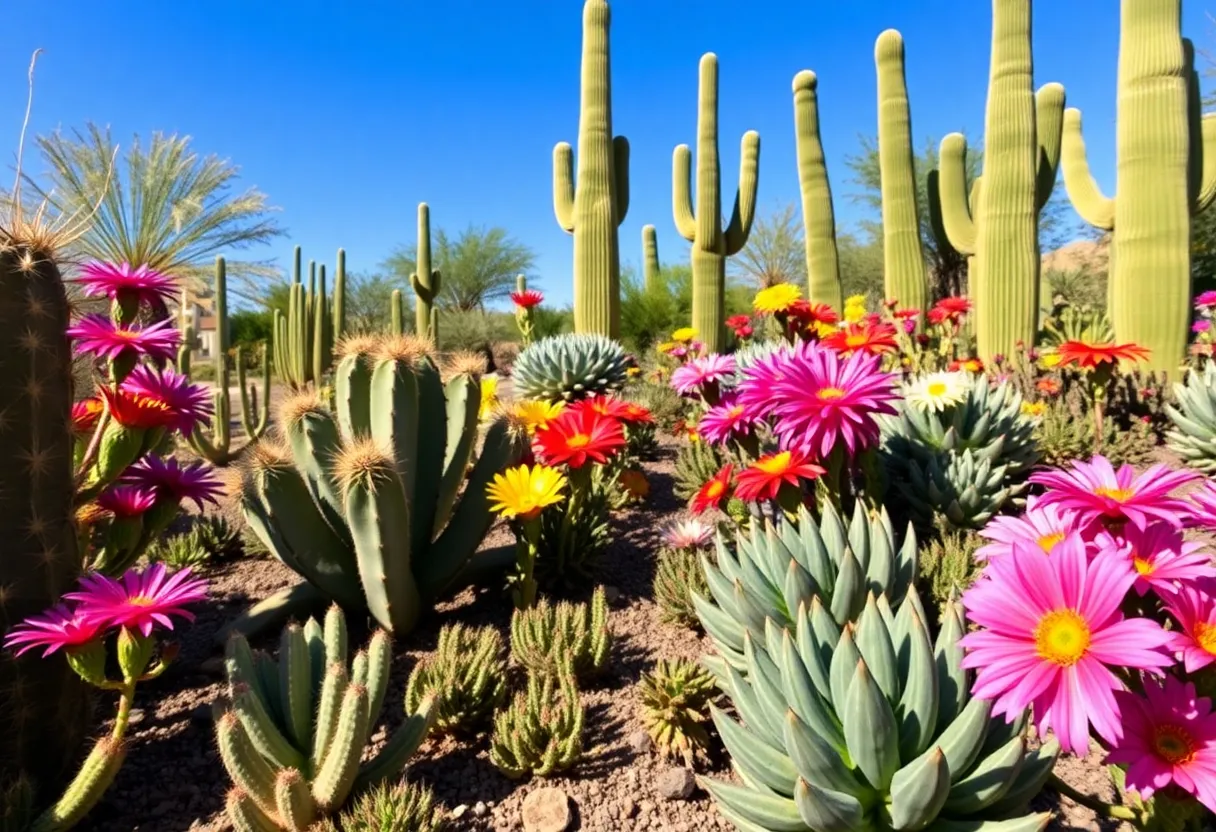Creating a Beautiful Native Plant Garden in Phoenix’s Arid Environment: A Sustainable and Rewarding Approach
Introduction
Designing a native plant garden tailored to Phoenix’s arid climate offers both environmental benefits and aesthetic appeal. By selecting plants that naturally thrive in desert conditions, gardeners can cultivate vibrant landscapes that *conserve water*, *reduce maintenance*, and support *local wildlife*. This approach aligns with sustainable landscaping practices crucial for urban expansion in desert regions.
Understanding Phoenix’s Climate
Climatic Characteristics
Phoenix experiences a typical hot desert climate, characterized by long, scorching summers and mild winters. The summer temperatures often exceed 100°F (38°C), with peaks reaching well above. Winters are relatively mild, rarely dropping below freezing. Rainfall is minimal, averaging less than 8 inches annually, primarily falling during the monsoon season in late summer. These conditions require vegetation choices that are drought-tolerant and heat-resistant.
Implications for Landscaping
Water scarcity and extreme temperatures mean that conventional lawns and non-native plants can be unsustainable. Instead, a focus on native plants ensures a landscape that naturally adapts to and withstands the arid environment. Such plants are resilient, requiring less water, fertilization, and pest control.
Advantages of Native Plant Gardens in Phoenix
Water Conservation
Native plants, adapted to Arizona’s climate, typically require significantly less water than non-native species. Once established, they often need only 10-15 gallons per square foot annually. In contrast, traditional lawns can use up to 60 gallons per square foot, leading to substantial water savings.
Low Maintenance
Native flora generally demands minimal inputs. They do not require frequent watering, fertilizing, or chemical treatments. This reduces the time and monetary investment required for landscape upkeep.
Wildlife Support
Native gardens serve as invaluable habitats for local pollinators, including bees, butterflies, and hummingbirds. By planting indigenous species, you help preserve biodiversity, ensuring a healthy ecosystem within your landscape.
Selecting Native Plants for Your Phoenix Garden
Strategic plant selection ensures a thriving, sustainable landscape. Focus on incorporating diverse plant types suited for specific garden zones and purposes.
Shade Trees
Palo Verde
Palo Verde (*Parkinsonia* species) is *Arizona’s state tree*. Its distinctive green bark and vibrant yellow blossoms in spring add visual interest. Its shade helps cool surrounding areas, supporting understory plants and reducing outdoor temperatures.
Desert Willow
Desert Willow (*Chilopsis linearis*) is a *fast-growing*, *attractive tree* with *trumpet-shaped flowers* that attract *hummingbirds*. It offers *dappled shade*, making it ideal for quiet outdoor spaces and reducing heat stress.
Shrubs and Perennials
Desert Marigold
Desert Marigold (*Baileya multiradiata*) blooms from spring to fall with bright yellow flowers. Its *perennial nature* and *pollinator appeal* make it a popular choice for low-maintenance beds.
Penstemon
Penstemon species have *tubular flowers* in shades of red, pink, and purple. They are *especially attractive to hummingbirds* and thrive under full sun and minimal water.
Cacti and Succulents
Saguaro
Saguaro (*Carnegiea gigantea*) is the *iconic desert cactus*. It can live over a century and provides shelter and food for *desert wildlife*. Its *columnar form* creates focal points in landscape designs.
Agave
Agave species are *architectural*, *fleshy-leaved succulents* that add visual structure and texture. They adapt well to poor soils and require minimal irrigation.
Groundcovers and Grasses
Bear Grass
Bear Grass (*Nolina microcarpa*) is a *native ornamental grass* that adds *movement* and *texture*. It tolerates dry conditions and complements other xeriscape elements.
Desert Marigold
Reiterated here as both a shrub and groundcover, *Desert Marigold* thrives in full sun, providing continuous *bright yellow blooms* that attract *pollinators*.
Designing Your Native Plant Garden
Soil Preparation
Desert soils are typically *sandy or rocky*, with *poor nutrient content* and *minimal water retention*. Improving drainage is vital. Incorporate organic matter and soil conditioners if necessary, ensuring roots do not become waterlogged.
Planting Layout
Group plants following *similar water and sunlight needs*. Use taller species like *Palo Verde* or *Desert Willow* as *backdrop*. Place smaller plants and groundcovers in the *foreground* to create depth and visual interest.
Irrigation Techniques
Implement a *drip irrigation system*, which delivers water directly to roots, minimizing evaporation and runoff. Water *deeply and infrequently* to promote *deep root growth*—a key adaptation to arid environments.
Mulching
Apply a *layer of organic mulch*, such as wood chips or gravel, around plants. Mulching *retains soil moisture*, suppresses weeds, and stabilizes soil temperature.
Maintenance Strategies for Native Gardens
Pruning and Deadheading
Remove *dead or diseased branches* to maintain plant health and encourage new growth. *Pruning* also helps shape plants and reduces pest habitats.
Fertilization
Generally, native plants require *minimal fertilization*. When needed, apply a *balanced, slow-release fertilizer*, avoiding excess nutrients that can promote unwanted growth and pests.
Pest and Disease Management
Promote *natural pest control* by encouraging *beneficial insects*. Use *organic pesticides* only as a *last resort* to protect native biodiversity.
Additional Resources and Tips
Visit local botanical gardens or native plant nurseries to observe species firsthand and gain ideas. These sources can provide expertise for plant selection and landscape design. Emphasize *sustainability* by minimizing water use and emphasizing native flora.
Conclusion
By carefully selecting and maintaining plants native to Phoenix’s desert environment, you create a *vibrant, sustainable landscape*. Such gardens reduce resource consumption, support local ecosystems, and provide aesthetic pleasures for years to come. Thoughtful planning, combined with appropriate plant choices, transforms outdoor spaces into resilient desert sanctuaries.
Frequently Asked Questions
| Question | Answer |
|---|---|
| What are the key advantages of native plant gardens in Phoenix? | They conserve water, require minimal maintenance, and support local wildlife such as pollinators and birds. |
| Which trees are recommended for providing shade in a native Phoenix landscape? | Palo Verde and Desert Willow are excellent options due to their drought tolerance and aesthetic appeal. |
| How should I prepare the soil for native plant planting? | Ensure well-draining soil, amend heavy soils with organic matter, and avoid allowing roots to sit in water. |
| What watering methods are most effective for native plants? | Deep, infrequent watering using drip systems or soaker hoses promotes healthy root systems and water efficiency. |
| Are fertilizers necessary for native plants? | Usually minimal, but a slow-release balanced fertilizer can be used if plants show signs of nutrient deficiency. |
Key Features of a Native Plant Garden in Phoenix
| Feature | Description |
|---|---|
| Climate Compatibility | Plants selected are adapted to high temperatures, low rainfall, and intense sun exposure. |
| Water Efficiency | Utilizes drought-tolerant species and efficient irrigation methods to minimize water use. |
| Support for Ecosystem | Provides habitat and resources for native pollinators, birds, and other wildlife. |
| Low Maintenance | Reduces need for fertilizers, pesticides, and frequent watering after establishment. |
| Aesthetic Value | Creates colorful, diverse landscapes that reflect the natural beauty of the desert environment. |
Author: STAFF HERE PHOENIX WRITER
The PHOENIX STAFF WRITER represents the experienced team at HEREPhoenix.com, your go-to source for actionable local news and information in Phoenix, Maricopa County, and beyond. Specializing in "news you can use," we cover essential topics like product reviews for personal and business needs, local business directories, politics, real estate trends, neighborhood insights, and state news affecting the area—with deep expertise drawn from years of dedicated reporting and strong community input, including local press releases and business updates. We deliver top reporting on high-value events such as the Waste Management Phoenix Open, Cactus League Spring Training, and Arizona State Fair. Our coverage extends to key organizations like the Greater Phoenix Chamber of Commerce and Visit Phoenix, plus leading businesses in technology and healthcare that power the local economy such as Intel and Banner Health. As part of the broader HERE network, including HERETucson.com, we provide comprehensive, credible insights into Arizona's dynamic landscape.





